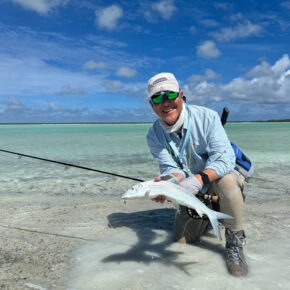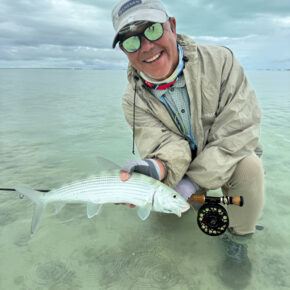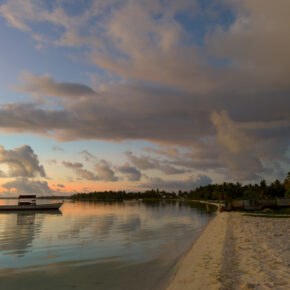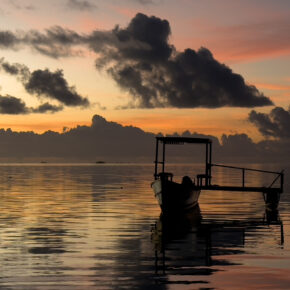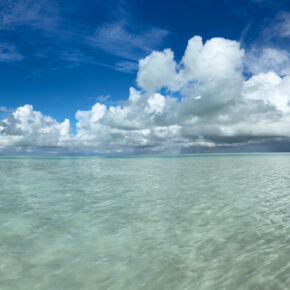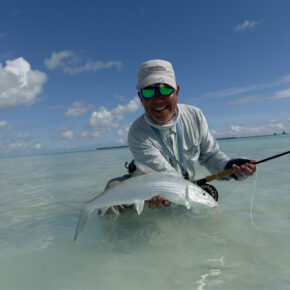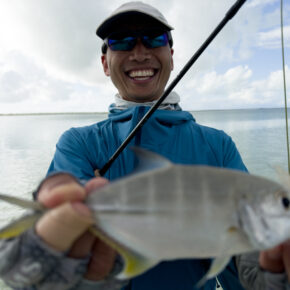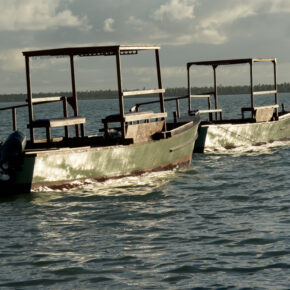The first call that came through to my cell phone as we touched down in Oahu, the midpoint of our journey to Kiribati, also known as Christmas Island, was the news that a Category 3 Cyclone was forcing the cancellation of our trip. All flights out of Fiji had been grounded, likely for a week, due to Cyclone Mal’s impending arrival, which was expected to bring flash flooding and gale to storm-force winds across the islands. Fiji Airlines, the sole carrier flying U.S. fishermen to Christmas Island, operates just one weekly flight from Fiji to Christmas Island and onward to Honolulu, shuttling eager fly fishermen to and from the States via Honolulu. My friend Bob and I had arrived a bit early to check into our hotel and found ourselves lingering around the airport, making calls to Fishabout and exploring possible flights back to the U.S. the following day.

I had heard stories of groups of fishermen stranded on Christmas Island for an additional week because Fiji Airlines couldn’t get a plane in the air, but I had never experienced a cancellation from Honolulu. So, it was quite a surprise when, two hours after our trip was officially canceled, we were informed that the trip was back on. My concern, however, was that the cyclonic weather would be close to Christmas Island, making it challenging to cast and spot fish throughout the week. As it turned out, all flights to and from Kiribati were on time, and the weather for the week ended up being fairly typical for Christmas Island. Being located on the equator seemed to shield the island from cyclones, maintaining relatively constant weather throughout the year. Although, if you forgot to put on your buff after taking pictures, you’d likely end up with a sunburn.
My previous visit to Christmas Island in 2018 was supposed to be a farewell trip, as in 2009, Al Gore and the UN had predicted that Kiribati would be submerged by rising sea levels due to climate change by 2013. However, that timeline has now been extended to the year 2100, 77 years from now, a time when I won’t be around to see the outcome. After a 37-month hiatus due to Covid-19, reports of exceptional fishing had piqued my interest, and I decided to join my long-time friend Bob Von Raesfeld for a last-minute fishing expedition. Both of us had numerous Christmas Island trips under our belts, and we were eager to see if the rumors were true about the bonefish being more prolific and massive than ever.
In short, the fishing experience turned out to be pretty typical for Christmas Island, not particularly exceptional. Perhaps the fish had become accustomed to the increased fishing pressure on the island this year. The island’s population, once 500 people, had grown to over 117,000, and there were now numerous fishing lodges on the island. Having only fished at Captain Cook and the Villages in the past, I talked to fellow fishermen at the airport to gather their impressions of fishing at other lodges. I used much of the same patterns Ive used for years with the exception of a size 4 EP spawning Shrimp that the Bones on some flats were crazy for. Ive made a habit of cutting off old flies that worked and leaving the leader knots on them. At the end of tbe day I put all my used flies in a vial of freshwater and keep them for next trip to remind me what I used.

After a 37-month absence, one might expect that the bonefish would have forgotten about flies and the presence of wading anglers, but it appeared that only 11 months of intense fishing pressure were required for them to adapt. Our day at the Milkfish Preserve was revealing. They no longer farm milkfish there, and there are no longer any barriers in the canal. The days of concentrated fish below the bridge and GTs gathering in the area seemed to be gone. During lunch, I managed to hand-feed bonefish with bread, as I used to do in years past. The guides explained that it was only possible in two areas because the bonefish had grown accustomed to it. It seemed that the bones had once again acclimated to the presence of fishermen. Chumming for larger bones on the flats with bread was not effective. Unfortunately, it seemed that the preserve would never be the same now that local fishermen preferred gillnetting milkfish closer to home instead of farming them in the ponds. I didn’t spot many GTs cruising the flats this year, even when I looked for them using a drone.
The bonefishing was average for Christmas Island. We missed the second week after the full moon by a week and it rained out one day. I caught an average of 12-20 fish a day averaging 12 -18 inches with my biggest about 5 lbs. Our group caught lots of small to midsize Blue and Golden Trevaly with am occasional Queenfish, Trigger, Snapper, goatfish, Puffers and a Surgeon fish on the flats. The final counts for the 6 of us according to Bob was
286 Bonefish landed to 6 lbs., 5 GT’s , 15 Blue Fin Trevaly, 16 Skip Jack , 2 Rainbow Runners , 1 Lady Fish, 1 Surgeon Fish and 1 Trigger Fish
Bob and I having been to Christmas Island in the past discussed prior to the trip what I call “Stupid Bonefish Games”. we decided we would try to catch a bonefish casting with our bare hands after being inspired by Lefty Krey bare hand casting technique. In theory it sounded plausible and fun since Bob and I had practiced throwing an 8 wgt bonefishing taper by hand on dry land casting a respectable 30 ft.- plenty long enough to catch a bonefish. Bob suggested using a tube for less friction and I suggested we hang the reel around the neck and then play the fish, should we hook one, directly from the reel – a Hardy Marquis click pall reel. Excited to spend the day trying to achieve the near impossible feat as we were dropped off on the flat with our guides with no rods and and a reel around Bob’s neck. we were quickly discouraged from trying after we tied a short leader and fly to the line. Its impossible to pull a sunken fly out of the water with a bare hand because it anchors too deep. Luckily the boat came back with a couple rods, Bob has caught bonefish at Christmas on a 3 wgt.

Inspired by Bob’s 3 wgt bonefish quest, I brought a 7 wgt Bad Ass Glass rod with a Hardy Marquis click pall reel to play with which turned out to be super fun and popular with the guides. The good fish I hooked screamed with every run sometimes backlashing the line even with with both palls engaged set at the highest drag. Palming every run was a necessity and the skill to learn was to palm the reel just enough to allow the fish a smooth long run with a constant rod bend to the cork. Mauro broke his 8 weight from a knot that got pulled and I lent him the Glass Rod to use instead of his 9 wgt. for a day, He loved the rig so much that he borrowed it again for another day and landed his biggest bone on it – a 7 lbr. We were both surprised how easy it was to wind line quickly.
Things got more wild and crazy on the Offshore day with Mauro, Dave and Joe. None of the other anglers besides myself had trolled flies offshore. II had brought two saltwater casting rods, an 11-weight and a 12-weight, equipped with high-capacity reels and superb drags, which I shared with the group. Since Joe had some medical issues, I had him use a baitcasting rod. Dave, on the other hand, utilized his heaviest rod, which was a 9-weight with a missing foot off the tip, making it closer to an 8-foot 10-weight, paired with a Wright and Miguel 9-weight fly reel I had never seen before. Dave, true to form, was the first to hook a formidable fish using this setup.

The fish initially tore off hundreds of feet of line, and Dave embarked on what we fondly referred to as the “winch” dance. Given Dave’s age of 80, I expressed concern and advised him to pass the rod if he felt fatigued, but Dave tenaciously persevered. With each pump of the rod, he managed to gain about 6 inches of line, and I decided to take a break to eat lunch. After lunch, I began filming Dave’s valiant battle with the fish. He had nearly retrieved the initial 100 feet of shooting line when the fish launched another powerful run, snatching an additional 100 feet of line. While filming, I watched in shock as the reel knob unexpectedly popped off Dave’s reel and onto the floor of the boat. I glanced at Dave and quipped, “We’re in trouble.” At that moment, Mauro began hand-lining the fish while Ekes reeled in the slack line with his finger. Regrettably, despite having fought the fish for about 30 minutes, the line eventually snapped at a knot, and we never laid eyes on that elusive fish. We playfully bantered with Dave about bringing a $70 reel on a $7,000 trip. It was an unforgettable moment.
We decided to go look for some MIlkfish to cast too, We started out casting flies for milkfish which ran in huge schools off the break. After 100s of good long casts Mauro and I struck out hooking any on our milkfish flies. The other group had landed two the day before after a big rainstorm and I later learned that the rain made the milkfish less spooky allowing the boat to get close enough to “floss” (snag) them with a short line casts.
 I tried casting my huge poppers for a big GT with no luck so we tried trolling again. I let Dave troll with my 12 wgt to get revenge for his tackle meltdown and I decided to sit out while the other three trolled flies and lures but we didn’t get any blowups trolling for about an hour. Ekes our guide suggested we troll back to the mouth of the Atoll and look for some better schools of milkfish so I took the pontoon position and trolled a 6/0 sailfish fly when it happened. At first I felt a bump like a striper bump and then I saw a wake come across from the side and swipe my fly without a take. Again from the opposite side it came and nipped the fly By this time Ekes stood up and started barking orders to the boatman to slow down and as he did, I started the tease, erratically stripping when the bill of a 8 foot sailfish rose out of the water directly behind the fly and ate. I set the hook ten times with everything I had as he began his run on the straight 80 lb test leader. All hell broke loose as the sailfish took off and started to jump as it ripped line from my Sage Specter set at 20lbs of pressure. The first jump was completely out of the water with line accelerating out of my reel with max pressure on my 9 and half foot 11 wgt. The second and third jumps seemed to be in slow motion and I encouraged the fish to burn that energy and I tried to get relaxed for the long battle ahead. The massive fish began to slow with 200 yards of line out and I managed to regain all the line from the first run with steady hard pressure steering him to toward the boat. I regained the first run quickly and felt that the huge fish would soon take another run. Amazed that he was still on I actually had a glimmer of hope that I might land it when I noticed the boatman hadn’t started the motor yet. At that moment the fish turned and took its second run straight out. I could picture the leader and line straight back on the fish as it accelerated like no other fish I have ever hooked. In a moment, I had lost all the line I had regained and all I could think about was turning the fish. I said out loud. “I have to break its spirit…” I put side pressure on the fish and it turned away, I put side pressure the opposite direction and it accelerated and suddenly I was unbuttoned. I felt like I was sawed off and didn’t expect a leader. I reeled in the 200 yds of backing and line and birds started diving on my fly as it got closer. I hadn’t lost the fly, it just pulled out. Bad luck. The leader was thrashed two feet above the fly from the bill. Maybe I would have had a better chance if we chased it. Ill never know. I don’t think the boatman knew what to do with a sailfish. That was the high point for me on the trip.
I tried casting my huge poppers for a big GT with no luck so we tried trolling again. I let Dave troll with my 12 wgt to get revenge for his tackle meltdown and I decided to sit out while the other three trolled flies and lures but we didn’t get any blowups trolling for about an hour. Ekes our guide suggested we troll back to the mouth of the Atoll and look for some better schools of milkfish so I took the pontoon position and trolled a 6/0 sailfish fly when it happened. At first I felt a bump like a striper bump and then I saw a wake come across from the side and swipe my fly without a take. Again from the opposite side it came and nipped the fly By this time Ekes stood up and started barking orders to the boatman to slow down and as he did, I started the tease, erratically stripping when the bill of a 8 foot sailfish rose out of the water directly behind the fly and ate. I set the hook ten times with everything I had as he began his run on the straight 80 lb test leader. All hell broke loose as the sailfish took off and started to jump as it ripped line from my Sage Specter set at 20lbs of pressure. The first jump was completely out of the water with line accelerating out of my reel with max pressure on my 9 and half foot 11 wgt. The second and third jumps seemed to be in slow motion and I encouraged the fish to burn that energy and I tried to get relaxed for the long battle ahead. The massive fish began to slow with 200 yards of line out and I managed to regain all the line from the first run with steady hard pressure steering him to toward the boat. I regained the first run quickly and felt that the huge fish would soon take another run. Amazed that he was still on I actually had a glimmer of hope that I might land it when I noticed the boatman hadn’t started the motor yet. At that moment the fish turned and took its second run straight out. I could picture the leader and line straight back on the fish as it accelerated like no other fish I have ever hooked. In a moment, I had lost all the line I had regained and all I could think about was turning the fish. I said out loud. “I have to break its spirit…” I put side pressure on the fish and it turned away, I put side pressure the opposite direction and it accelerated and suddenly I was unbuttoned. I felt like I was sawed off and didn’t expect a leader. I reeled in the 200 yds of backing and line and birds started diving on my fly as it got closer. I hadn’t lost the fly, it just pulled out. Bad luck. The leader was thrashed two feet above the fly from the bill. Maybe I would have had a better chance if we chased it. Ill never know. I don’t think the boatman knew what to do with a sailfish. That was the high point for me on the trip.
Following the incident with the “farmed” sailfish, all rods were promptly back in the water as we continued trolling. It didn’t take long for us to hook into some Skipjacks, providing a thrilling experience for those who had never caught tuna on a fly before. We also managed to land a couple of Rainbow Runners and a 10 lb f Trevalley. Soon enough, another sailfish surfaced behind Mauro’s fly on the outer pontoon, swiping at the offering and then devouring Joe’s lure, initiating a blistering run that left Joe struggling to maintain control of the rod. Unfortunately, as the line dug into the spool and froze, the 80 lb braid suddenly snapped, marking the end of that eventful encounter. This episode taught us an important lesson: you cannot troll a baitcasting rod immediately after casting unless you first rewind the line tightly onto the spool.
After Joe retired following his bout with the sailfish, I decided to take the middle trolling position. I hooked a Skipjack and instructed the boatman to continue trolling until someone else had a hookup, which turned out to be an effective strategy for attracting larger fish to the outer flies. We soon hooked a substantial Trevalley before I reeled in a smaller Skipjack, which Ekes quickly cleaned so we could enjoy fresh Skipjack sashimi right there on the boat. Despite lacking soy sauce and wasabi, it was a satisfying treat. Dave then took over my 12-weight rod, having retired his 9-weight and unconventional reel, and soon hooked another Skipjack, leading to more trolling excitement. However, Dave’s started screeming line out and we momentarily stopped the boat to allow him to grapple with what we suspected was a shark due to his earlier Skipjack catch. Dave played the huge fish for about 5 minutes this time with a substantial fly reel and rod. Eventually, the line went limp once more, and Dave reeled in the remnants of the Skipjack, only for us to spot another sailfish trailing behind it. As it turned out , Dave was playing that sailfish that ate his skipjack. Ekes resumed the boat’s slow trolling, while Mauro and I let out our flies in an attempt to position ourselves in front of the pursuing sailfish. The sailfish took a liking to Mauro’s fly, diligently following it and eventually disappearing from view, perhaps growing tired of the Skipjack Dave was towing. That day, all four of us had a shot at landing a sailfish, which added a thrilling dimension to our adventure.
The Villages sets the gold standard for Christmas Island. First opened in June 2006, it quickly gained a reputation as the best location with the most comprehensive fishing program on the island, thanks to the late Kay Mitsioshi, who collaborated with investors from Los Gatos to design the perfect fly-fishing lodge on the island. Fishabout agreed to apply all profits from the VIllages to the church for one year before becoming exclusive. The Villages is now owned by the Church and has close ties to Fishabout, Nervous Waters, and Yellowdog. Situated on the pristine white sands of Discovery Beach, The Villages offers breathtaking views of the ever-changing aqua waters of the atoll’s lagoon. Its prime location near all the best flats within the atoll often puts its guests on the most productive flats before other lodges. Most of the island’s top guides work for The Villages, and each fisherman is paired with their own guide. Perhaps it’s my age, but the guides felt somewhat different from those in the past. Most were my son’s age and had never met Tenake, but there were a few older guides like Ekes I had known for over a decade, and fishing with them felt like old times, even though we didn’t have the option to choose our guides.
A COVID-19 outbreak among the guides created a shortage for the 17 anglers at the lodge. Our group of 6 consisted of Bob, Mauro, Mike, Garrett, Dave, and myself. Despite the COVID-19 closures, Kiribati was still experiencing outbreaks similar to those in the United States. I was told they had received vaccines from Australia, China, and the US, but there was still a lot of coughing, and some guides were missing despite the vaccinations. Several guests were also coughing, but the flats were vast, allowing us to isolate ourselves and take precautions. Still, I had little faith that a buff could filter out a sneeze in close proximity. As far as I know, no one in our group contracted COVID-19 during the trip.
The food was different from what I remembered in previous years. Noticeably absent were the sashimi appetizers and dishes, lobster, breadfruit, and mantis shrimp. The meats were often overcooked, but that was typical. Most evenings, the menu consisted of potatoes, stir-fry, white rice, and a fish dish if someone had brought something back from offshore. We enjoyed milkfish, tuna, and rainbow runner on three nights as the fish dishes. The coffee was of better quality, and there was an ample supply of Tabasco sauce to keep me satisfied. Breakfasts typically featured eggs, bacon, and toast, with occasional servings of pancakes or French toast. The best addition to the dinners was ice cream for dessert every night. The luau on the final night provided entertainment with live performances by local children on PVC xylophones and dancing by local church women. However, the luau food was similar to other dinners.
Flats fishing for bonefish is the primary draw of Christmas Island for me, and once again, I’m filled with excitement as I navigate its stunning flats with some of my closest fishing buddies. Our days are mostly spent laser-focused on the water, scanning for these elusive bonefish, which often seem like ethereal apparitions. However, whenever I manage to tear my gaze away from the water’s surface, I’m treated to the breathtaking sights of Kiribati’s natural beauty, including the graceful flight of birds and interactions with the island’s native inhabitants – still breathtaking and close to my heart.











